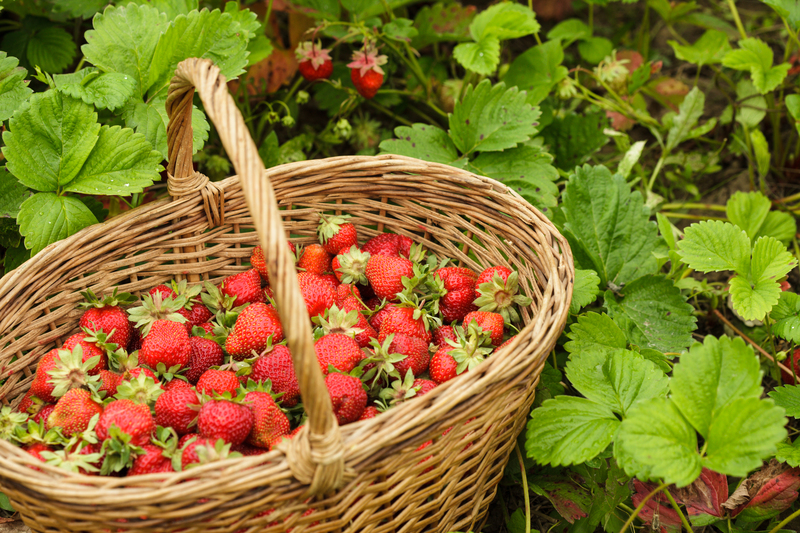Preventing Weather-Induced Chaos in Your Garden Haven
Posted on 30/08/2025
Preventing Weather-Induced Chaos in Your Garden Haven: Comprehensive Protection Tips
Your garden is your sanctuary -- a tranquil haven where you can relax and soak in the beauty of nature. However, unpredictable weather can wreak havoc on even the most well-tended gardens, leaving you frustrated and your plants battered. Fortunately, with proactive planning and smart strategies, preventing weather-induced chaos in your garden haven is entirely achievable.
This article explores the best practices to protect your garden from extreme weather, safeguard your green investments, and ensure your outdoor space flourishes in any season. Whether you're a novice or a seasoned gardener, our expert advice will help you fortify your outdoor retreat against the forces of nature.

Understanding the Effects of Weather on Gardens
Weather extremes can have various impacts on gardens. From torrential rains and fierce winds to unexpected frosts and scorching heatwaves, garden weather hazards threaten the health and longevity of your plants and landscaping features.
Common Types of Weather Damage:
- Heavy Rain and Flooding: Can cause soil erosion, root rot, and wash away nutrients.
- Strong Winds: May break branches, uproot plants, and damage structures.
- Frost and Freezing Temperatures: Kill tender plants, damage leaves, and disrupt tree growth cycles.
- Heatwaves and Drought: Cause wilting, sunburn on leaves, and increase pests and diseases.
- Hailstorms: Tear leaves, bruise fruit and vegetables, and compress soil.
To create a resilient and weather-proof garden haven, start by analyzing the local climate, studying seasonal trends, and determining which types of extreme weather most commonly affect your area.
Assessing Your Garden's Vulnerability
Before you can effectively prevent weather trauma in your garden, it's essential to identify which areas and features are most at risk. Key points to consider include:
- Soil Type and Drainage: Poorly drained soil is prone to waterlogging and root damage in storms.
- Sun and Wind Exposure: Open, unshielded spaces are vulnerable to windburn and heat stress.
- Garden Layout: Plants positioned on slopes may suffer erosion, while low-lying areas can flood easily.
- Plant Selection: Delicate, non-native species often lack resilience to local weather extremes.
A thorough garden vulnerability assessment forms the foundation for effective garden weather protection strategies.
Top Strategies for Preventing Weather-Induced Chaos in Your Garden
1. Choose Weather-Resistant Plants
Plant selection is crucial for a resilient garden. Opt for native or regionally adapted plants known for their ability to withstand local weather extremes. These plants tend to:
- Require less water.
- Resist pests and diseases native to the area.
- Recover quickly after heat, frost, or wind events.
When planning your garden beds, mix perennials, shrubs, and groundcover to create layers of protection, while diversifying plant species to reduce the risk of total loss during storms.
2. Enhance Garden Drainage
Proper drainage is one of the most effective ways to prevent storm damage in gardens. Consider the following techniques:
- Install French drains or soakaways: Direct excess water away from plant roots.
- Build raised beds: Elevate sensitive plants above flood-prone ground.
- Mulch: Mulch protects soil structure and helps water soak in gradually.
- Rain gardens: Create shallow, vegetated basins designed to collect and drain runoff safely.
*Tip:* Test your soil's drainage with a simple percolation test. Dig a hole, fill it with water, and observe how quickly it drains -- slow drainage signals a need for improvement.
3. Prevent Wind Damage
Gale-force winds can be devastating to gardens, especially during storms. To protect your garden sanctuary from wind-induced chaos:
- Plant windbreaks: Strategically placed shrubs and hedges can shield delicate plants.
- Use garden fencing: Fences provide an added buffer but should allow some airflow to prevent turbulence.
- Stake young trees: Use soft ties that won't damage bark, and check supports regularly.
- Avoid solid walls: Permeable barriers break the wind's force while preventing it from funneling over the top.
Regularly inspect trellises, arbors, and any lightweight garden structures, securing or storing them before high-wind events.
4. Protect Against Frost and Cold Snaps
Nothing causes more anxiety than an unexpected freeze just as your garden begins to bloom. Here's how to prevent frost damage in your garden:
- Cover with frost cloth: Lightweight, breathable fabrics can be draped over plants overnight.
- Use mulch generously: Mulching insulates soil and stabilizes root temperature.
- Move pots indoors: Portable containers can be relocated to sheltered spots or indoors until the threat passes.
- Water before frosts: Damp soil retains heat better than dry soil, offering extra root protection.
Early-morning sprinkling can help melt frost off delicate leaves, minimizing damage further.
5. Shade Your Garden During Heatwaves
Rising temperatures can trigger heat-induced chaos in your garden refuge. Combat sun scorch and dehydration with these tips:
- Install shade cloth: Shade sails and garden umbrellas reduce direct sun exposure.
- Mulch thickly: Retains moisture and shields vulnerable root systems from heat.
- Create temporary shelters: Use lightweight frames with old sheets or burlap to protect sensitive crops during midday heat.
- Water deeply and early: Irrigate early in the morning to limit evaporation loss.
Regularly monitor for signs of heat stress, such as leaf curling or yellowing, and act quickly to provide relief.
6. Build Resilient Garden Structures
Structures like pergolas, greenhouses, and sheds can both add beauty and function as vital garden shelters from extreme weather. Ensure they are:
- Securely anchored: Use concrete footings or ground pegs to resist wind lift.
- Made from durable materials: Weather-treated wood, galvanized steel, or reinforced plastics last longer in harsh conditions.
- Fitted with guttering: Collect roof runoff with integrated rainwater systems.
A well-designed garden shed or greenhouse can double as a refuge for your most precious potted plants during storms or cold snaps.
Regular maintenance keeps your garden resilient to sudden weather shifts. Key seasonal chores include:
- Removing dead or weak branches before storms arrive.
- Inspecting and repairing fences, trellises, and other structures.
- Maintaining a tidy garden floor to prevent debris accumulation and pest infestation.
- Refreshing mulch and compost as required.
Seasonal cleanup improves airflow, reduces disease risk, and ensures rainwater drains away efficiently.
Smart Technology and Tools for Weatherproof Gardening
Weather Monitoring Gadgets
Modern gardeners can leverage technology to stay one step ahead of the weather. Weather apps and smart garden sensors can alert you to impending storms, frost warnings, or extreme heat, providing valuable time to activate protective measures.
- Soil moisture sensors: Trigger irrigation when needed, preventing over- or under-watering.
- Remote weather stations: Offer real-time localized updates on temperature, wind, rainfall, and more.
- Automated irrigation systems: Adjust watering schedules based on actual weather conditions, saving time and resources.
Proactive Disaster Planning
Have a plan for emergency garden protection:
- Keep frost blankets and tarps readily accessible.
- Store portable pots and lightweight items where they can be moved quickly.
- Know how to shut off or protect outdoor water sources before a freeze.
The Importance of Soil Health in Weather Resilience
Healthy soil acts as a buffer against the destructive impacts of storms and drought alike. Build robust soil structure by:
- Incorporating organic matter like compost and leaf mold to improve moisture retention and infiltration.
- Practicing no-dig gardening to preserve beneficial soil microbes and minimize compaction.
- Testing soil pH and nutrients to ensure optimal plant health year-round.
For the best long-term outcome, prioritize soil health in every season. A thriving soil ecosystem can absorb rainfall more efficiently, resist erosion, and provide steady nourishment even during weather extremes.
Eco-Friendly Steps to Manage Weather Extremes
While protecting your garden oasis from extreme weather, consider sustainable solutions:
- Collect rainwater: Utilize barrels or integrated tank systems to catch runoff for later irrigation, reducing reliance on mains water during drought.
- Create wildlife habitats: Encourage birds, bees, and beneficial insects that support plant health and aid in pollination after storms.
- Practice water-wise gardening: Plan drought-tolerant borders and group plants with similar water needs together.
- Avoid harmful chemicals: Choose organic fertilizers and pest controls to keep soil and waterways healthy, especially after heavy rains.

Frequently Asked Questions: Preventing Weather-Induced Chaos in Your Garden Haven
Q1: What should I do hours before a big storm hits my garden?
Secure loose items, stake tall plants, cover tender crops, and check all drainage pathways. Move potted plants to sheltered spots if possible, and make sure all garden structures are tightly anchored.
Q2: Which plants are best for weather-resilient gardens?
Choose native, drought-tolerant, and wind-resistant species suited to your local climate. Check with local nurseries or extension services for the best recommendations for your area.
Q3: How often should I inspect for weather-related damage?
After any significant storm or extreme weather event, conduct a thorough inspection to catch problems early. Regular monthly checks can prevent slow-developing issues such as rot or structural weakening.
Q4: Can organic gardening methods help prevent weather damage?
Absolutely! Healthy, organically managed soil and robust plant communities are more resilient to weather extremes such as drought and flooding. Mulching and composting, in particular, act as protective buffers for both plants and soil.
Conclusion: Create a Weather-Resilient Garden Retreat
Building and maintaining a weather-resilient garden haven does not require a complete overhaul -- just smart planning and regular care. By choosing the right plants, improving soil health, enhancing drainage, and incorporating shade and windbreaks, you can safeguard your tranquil space from nature's wildest tantrums. Leveraging technology and eco-friendly methods ensures that your garden will remain a source of beauty and peace, no matter what the weather brings.
With proactive action and thoughtful preparation, you can truly prevent weather-induced chaos in your garden haven and enjoy your outdoor sanctuary season after season.
Do you have garden weather protection tips or stories? Share your experiences below to help others cultivate resilient gardens!



